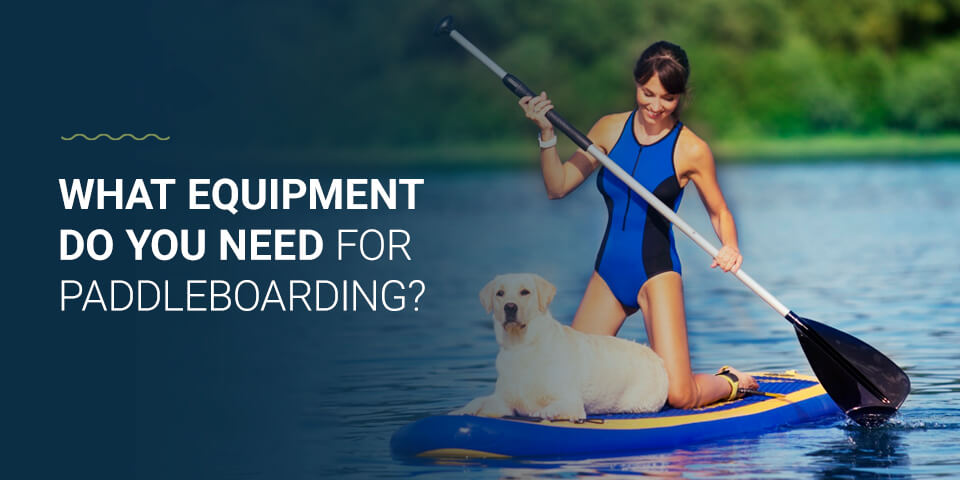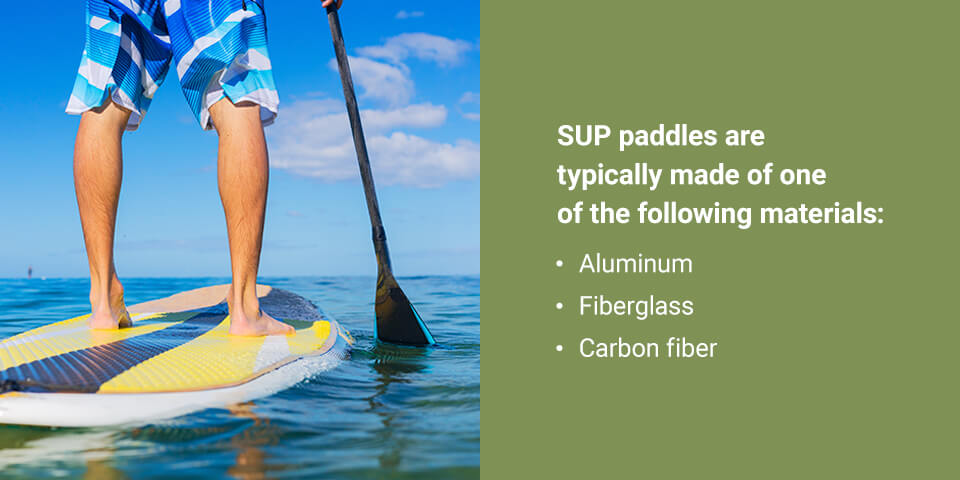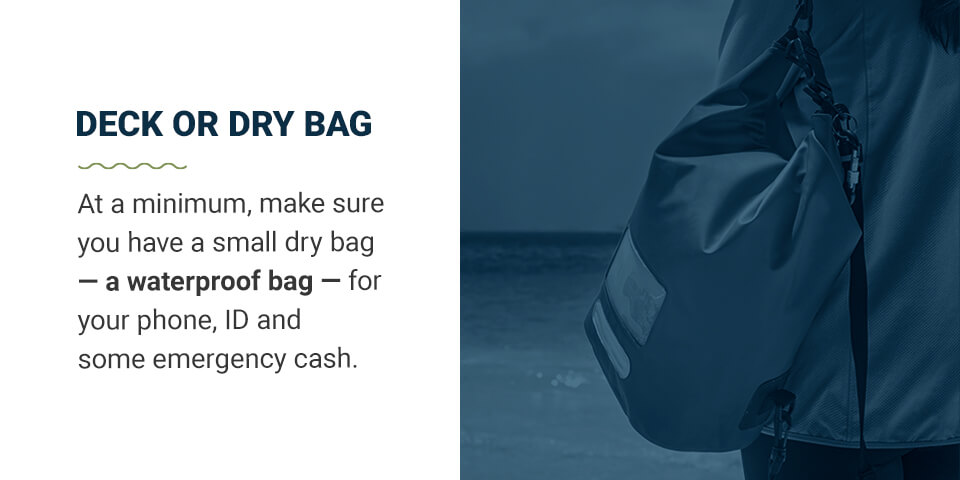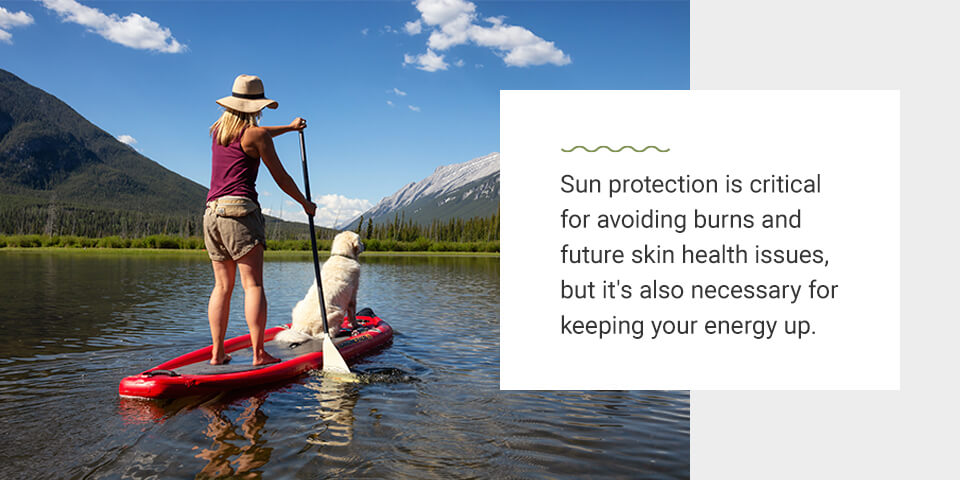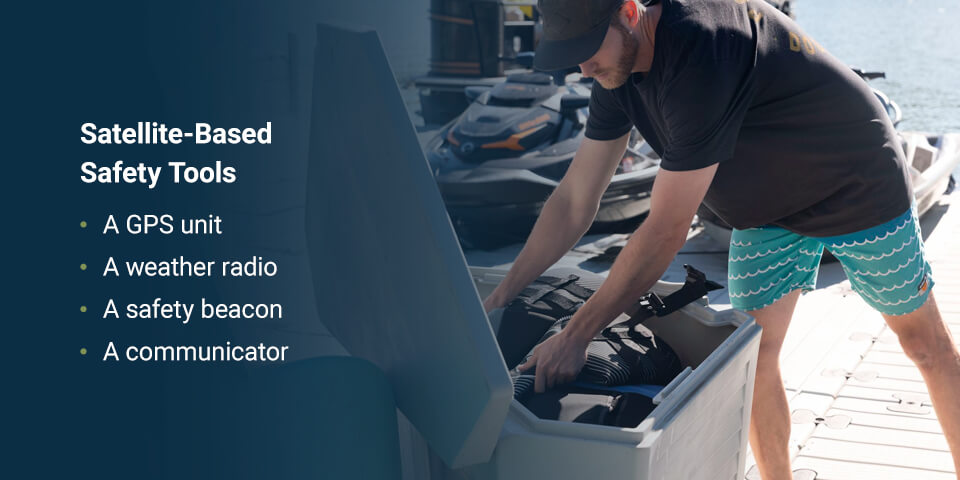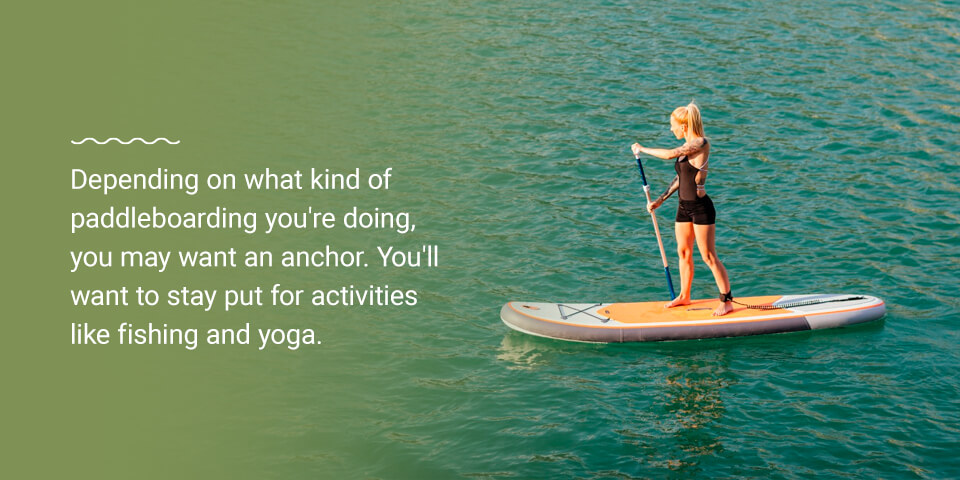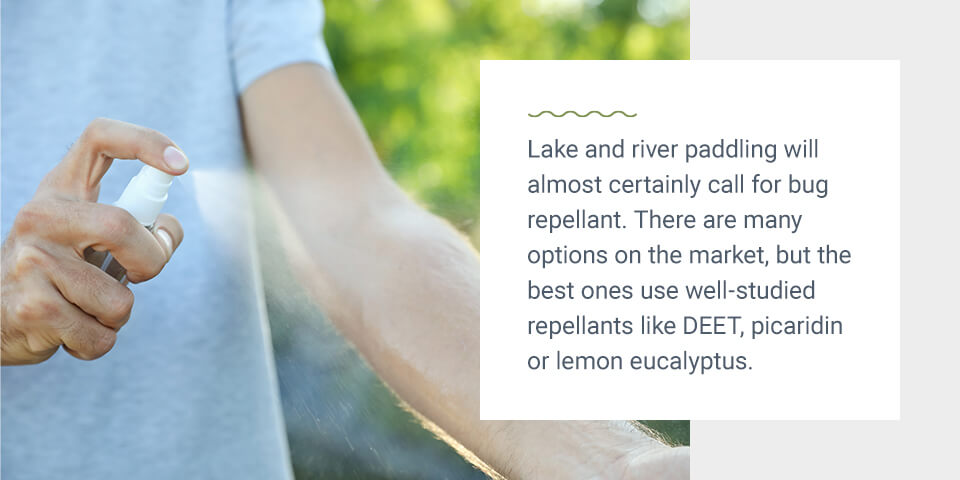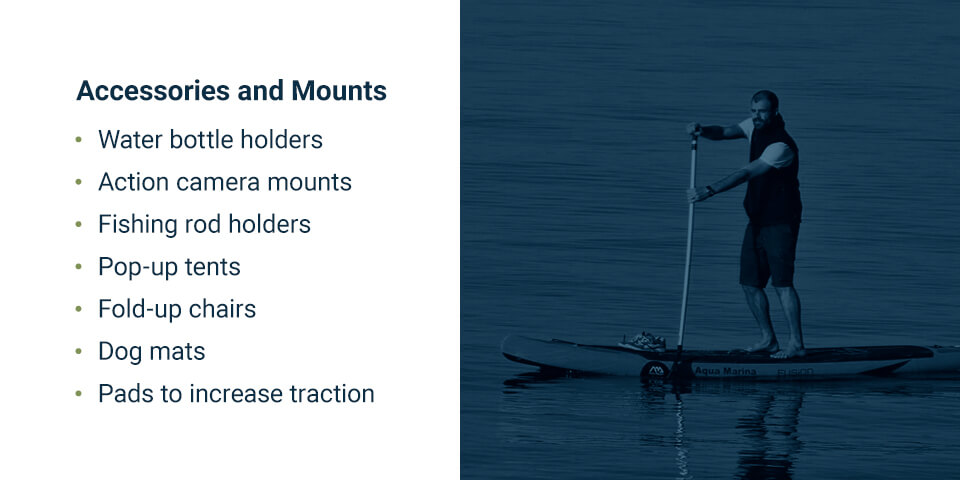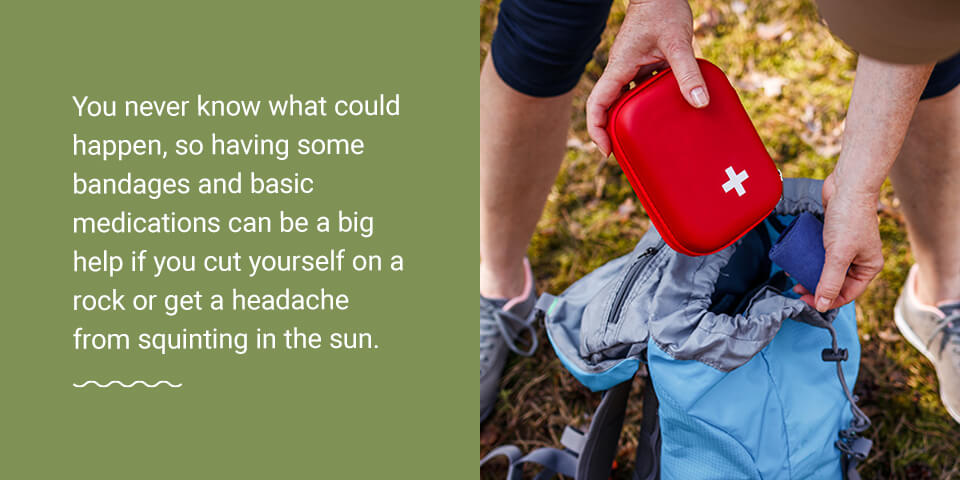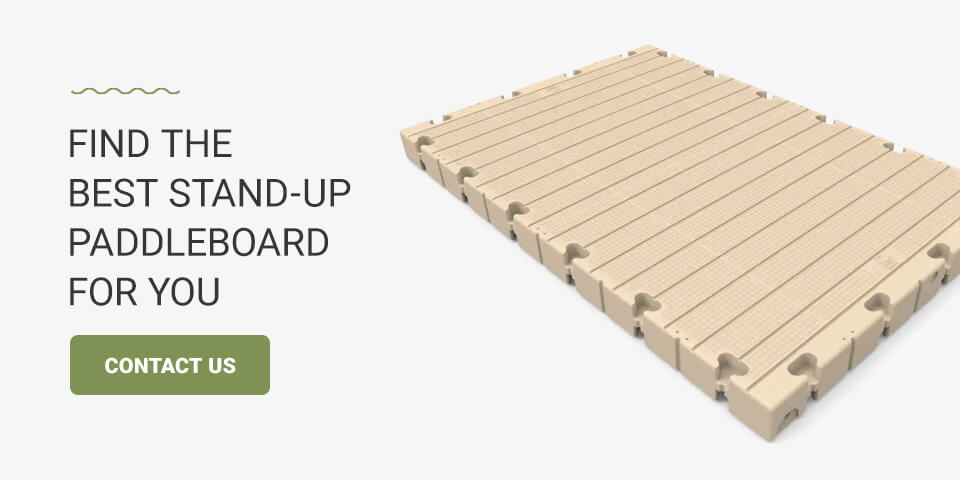Filters
What Equipment Do You Need For Paddle Boarding?
Stand-up paddleboarding (SUP) is an incredible sport that’s attracting more people every year. If it caught your attention, you might wonder what you need to start paddleboarding. Even experienced paddleboarders looking for an upgrade need the right gear.
SUP is a versatile activity for people of all ages and skill levels, so you have a lot of equipment to choose from. Let’s explore paddleboard equipment and how you can prepare for an amazing experience on the water.
What Is Paddleboarding or SUP Boarding?
Stand-up paddleboarding is a diverse watersport similar to surfing. You stand on a board — which is wider and larger than a surfboard — and use a paddle to propel yourself through the water, including oceans, lakes and rivers. SUP comes in many varieties, from relaxing activities like yoga and fishing to fast-paced surfing, touring and racing. You can also kneel or lie on the board for regular paddleboarding, but the stand-up version tends to be more popular.
With so many potential ways to paddle, you’ll find many different types of equipment on the market.
Essential Stand-Up Paddleboard Gear
Wherever you’re going with your SUP, there are a few pieces of equipment you’ll absolutely need.
1. Paddleboard
A paddleboard might seem simple at first glance, but many different factors go into choosing the right one, such as:
- Type: You can choose between hard and inflatable boards. Beginners typically start with inflatable boards, which are durable and easy to carry around. They also respond better to minor collisions like rocks and plants. Hard boards tend to perform better, with more stability and speed, and come in more shapes and sizes. If you get an inflatable board, you’ll need an air pump. Manual air pumps are cheap but slow and require some elbow grease. Electric pumps usually use the outlet in a vehicle and are much faster.
- Hull: The hull of your paddleboard determines how it interacts with water. A planing hull looks like a surfboard, with a rounded nose and a flat, wide body. It offers more stability, so it’s good for slow activities like SUP yoga and leisure paddling, as well as those that need more control, like white-water paddling. A displacement hull’s pointed nose helps it cut through the waves for greater speed. This option is suitable for fast activities like racing and touring.
- Length: The size of your board can significantly affect performance. A longer board — over about 12 feet — can be harder to steer but moves quickly for speed or long-distance activities. For general-purpose paddleboarding, look for a board that’s about 10-11 feet long. If you’re on the smaller side or buying for a child, go below 10 feet or look for a kid’s board.
- Width: All-purpose boards are usually around 32-34 inches wide. Narrower boards offer more speed and straight tracking for a fun ride, while wide boards offer stability. This stability comes at a cost, as a wider board will be slower and make paddling more difficult. Still, if you plan to carry a lot of things or bring a pet along, you may need more room.
- Thickness: Most boards are about 5 inches thick, which is an excellent general-purpose choice. Heavier riders may want to bump up to a 6-inch board for more support. Only lightweight, experienced riders should consider dropping to a 4-inch board.
- Fins: The fins of your board can help with steering and control. Larger fins can help you ride a straight, steady path, while smaller fins improve maneuverability and are suitable for fast-moving sports like surfing and racing. You can also choose between setups with one fin, three fins or a two-and-one configuration. The two-and-one option has a large fin surrounded by two smaller ones.
2. Paddle
Perhaps just as important as your board, the paddle can come in various styles and sizes. Factors like weight, handle design and adjustability will determine how comfortable your paddle is and how it supports different SUP activities. A paddle that wears you out in 10 minutes isn’t one you want to take on a long-distance tour.
SUP paddles are typically made of one of the following materials:
- Aluminum: Aluminum is usually the lowest-cost option, offering paddles on the heavier side.
- Fiberglass: Fiberglass is heavier and sturdier but often blended with carbon fiber. The result is a paddle with good all-purpose performance across durability, weight and cost.
- Carbon fiber: A paddle made of 100% carbon fiber is the lightest and strongest choice.
When it comes to height, look for a paddle that’s about 6-8 inches taller than you. Many paddles have adjustable shafts, so you can find the right size for you and share your paddle with friends and family. Consider getting a paddle with a textured shaft, too, which can help you get a good grip even when your paddle gets wet.
The blade of a paddle will most likely be plastic, but some higher-end paddles have compressed fiberglass or carbon fiber blades. Plastic blades are affordable and can deal with plenty of dings and dents, while other materials can chip if they hit an obstacle. The downside of plastic is that it isn’t very light, but manufacturers can use a wide range of plastic materials and technologies to create a lighter blade. Consider the overall weight of the paddle when choosing a blade material.
Consider the size of the blades, too. Large blades can move more water in one push for a faster paddle but require more strength. Smaller paddles might be slower, but they’re easier to use, especially for beginners or people looking for a low-stress activity.
3. Personal Flotation Device
A personal flotation device (PFD), such as a lifejacket, is an essential piece of safety gear. In many cases, the law requires you to have a PFD when heading out with your SUP. This depends on where you’re paddling, so check with local authorities or your state laws for more information. Always take a PFD with you, even if it’s optional or you’re a strong swimmer. You never know when rip tides, strong currents or bad weather might crop up. Most paddlers opt for Type III PFDs.
Thankfully, modern PFDs often have low profiles and stay out of your way so you can paddle freely. Look for inflatable life jackets, which can be in the classic vest shape or tucked away into a belt that resembles a fanny pack. You can also get a backpack-style PFD. Some can inflate automatically when submerged in water, while others require you to pull a tab. Automatic inflation and vest-style designs are best for rough waters because they can help keep your head above water if you lose consciousness.
You also want your PFD to be comfortable, so look for something that has good ventilation and is lightweight. Many PFDs also offer pockets — including waterproof dry pockets — and rings for attaching accessories, such as a safety whistle.
4. Leash
It’s a simple piece of equipment but an important one. A paddleboarding leash keeps you tethered to the board when you fall off. It attaches to your ankle, usually with a hook-and-loop strap. A coiled, tangle-resistant cord links you up to your SUP.
SUP leashes are especially important if you’re paddling in choppy waters or not wearing a PFD. If you’re heading to a place where your leash could get tangled, such as rapids or rivers, get one with a quick-release option. If your leash gets caught, you can detach it to prevent it from pulling you under.
What to Wear Paddleboarding
The best clothing for a paddleboard session depends on where you’re paddling and what the weather looks like. Some of your options on hot, warm or cool days include:
- Swimsuit: If you’re in a bug-free area with minimal wind, a simple swimsuit is a great pick. It gives you a full range of motion and lets you easily hop in the water for some swimming. Just be sure to pair it with some sunscreen.
- Rash guard: Rash guards work well in hot and cool weather. These long-sleeved shirts protect you from harsh sun, keep you warm in cold or windy conditions and prevent chafing. Make sure you buy one that dries quickly so you aren’t soaking wet while you paddle.
- Wetsuit: A thigh-length or full-body wetsuit is a must-have for colder days, especially if you’ll end up in the water. Wetsuits use an insulating neoprene fabric to keep you warm even in extremely cold water. Many lake paddlers use them in the spring and fall.
- Hat: Most paddleboarding locations won’t offer any shade. Bring a hat to protect your scalp from harsh ultraviolet (UV) rays. A baseball cap works well, but wide-brimmed, bucket-style hats are also popular. These hats often float, offer more coverage to protect your neck and shoulders and include chin straps to keep your hat from flying away in strong winds.
- Water shoes: Water shoes are optional, but they offer a few perks. They can help you traverse rocky terrain, like lakebeds or beaches, and give you more traction to help you stay on your SUP. They also offer another layer of sun protection. Look for lightweight shoes with good drainage.
Paddling in colder weather calls for a more specialized wardrobe. You need clothes that will keep you warm but dry off quickly. Remember, water can be much colder than air, and even a few minutes in unsafe water temperatures can cause hypothermia or other problems. Wetsuits or rash guards are vital and can provide the bulk of your thermal protection. Other accessories to keep you warm include paddling gloves and wetsuit boots. Opt for warm, fast-drying socks and hats made of wool or synthetic materials.
Optional Stand-up Paddleboard Gear
You can certainly head out to the water with the equipment we’ve already mentioned, but the following items can take your experience to the next level. Most paddleboards come with D-rings to attach different accessories.
1. Deck or Dry Bag
A deck bag can keep your belongings safely strapped to your board. They’re often waterproof, but not all are. At a minimum, make sure you have a small dry bag — a waterproof bag — for your phone, ID and some emergency cash. A deck bag might look like a square box, a half-cylinder or a backpack for your board. The entire deck bag could be a dry bag, but dry bags can also be much smaller, like a small pouch.
2. Sun Protection
Remember, you probably won’t have any shade on the water, so bring quality sunscreen and sunglasses along for the ride. Pick sunglasses with full-spectrum UV protection, and ensure they float or buy floating sunglass straps or retainers. Look for reef-safe sunscreen if you’ll be paddling in the ocean.
Sun protection is critical for avoiding burns and future skin health issues, but it’s also necessary for keeping your energy up. Keep yourself safe from harsh sunlight so you can power through your paddleboarding plans.
3. Food and Water
If you’re heading out for a longer trip, bring some water and nutritious snacks to keep you going. You can even get coolers that attach to a SUP. Classic snacks like jerky and trail mix are always a good choice.
4. Satellite-Based Safety Tools
You probably have GPS and weather tools on your phone, but if you go out of range of your cell signal or your device falls in the water, they won’t help much. If you plan to leave the coastline, paddle for long periods or go to riskier areas, consider bringing satellite-based tools, such as:
- A GPS unit: Maybe you fell off your board and can’t tell which way you came from. A GPS unit can guide you back, with special mapping and navigation tools to help you get around.
- A weather radio: Weather changes can be particularly dangerous on the water. Bring a compact weather radio to stay on top of any news. They often run on batteries, but you can also find radios that work via a manual crank.
- A safety beacon: Safety beacons include personal locator beacons (PLBs) and emergency position indicating radio beacons (EPIRBs). These devices use various technologies to connect you with emergency satellite systems and send out bright and infrared strobes to guide rescuers to your location.
- A communicator: Satellite communicators can include various features, like two-way messaging or radio, breadcrumb trails, location sharing and SOS alerts.
Many of these tools are combined into single devices, so you don’t need to bring a bunch of electronics. For example, a satellite communicator might have a weather radio and safety beacon built in. Make sure that your safety tools are waterproof and buoyant.
For frequent adventurers, safety tools are essential. Even if you only go off-grid once in a while, low-cost devices can help you stay safe and offer peace of mind.
5. Anchor
Depending on what kind of paddleboarding you’re doing, you may want an anchor. You’ll want to stay put for activities like fishing and yoga. An anchor should be heavy enough to keep you from drifting away but not so heavy that it’s difficult to take along. Thankfully, you can find SUP anchors designed for the job.
6. Waterproof Speaker
Take your tunes on the water with a speaker. Make sure it’s fully waterproof, not water resistant. A water-resistant speaker might withstand the occasional splash, but a waterproof speaker can be totally submerged and stay functional, even if your board flips.
7. Bug Repellant
Lake and river paddling will almost certainly call for bug repellant. There are many options on the market, but the best ones use well-studied repellants like DEET, picaridin or lemon eucalyptus. Bring bug repellant with you, and remember to reapply if you’re on the water for more than a few hours.
8. Accessories and Mounts
You can attach plenty of things to your SUP to improve your experience, such as:
- Water bottle holders
- Action camera mounts
- Fishing rod holders
- Pop-up tents
- Fold-up chairs
- Dog mats
- Pads to increase traction
Whether you want to take your furry friend on the water or pop up a tent and take a shaded nap, stand-up paddleboard accessories make it possible.
9. Headlamp or Light
A night SUP session can be a thrilling experience — and a great way to see evening shows like fireworks displays and meteor showers. U.S. laws typically require SUPs to have a white light on at all times after dark. It can help prevent collisions with watercraft and allow you to see the water, wildlife and any fellow paddlers nearby.
SUP lights come in many styles. You can wear a headlamp, attach a spotlight above your board or add underwater lights to the bottom of the board. Along with the white light to make you water-legal, you can use other lights to deck out your SUP. Add a rope light around the edge of your board or color-changing lights for a flashier experience.
10. First Aid Kit
Lastly, grab a first aid kit to toss into your bag. You never know what could happen, so having some bandages and basic medications can be a big help if you cut yourself on a rock or get a headache from squinting in the sun.
Gear for Transporting Your SUP
While you’ll spend most of your time on the water, think about how you’ll get there. No matter what kind of board you have, SUPs are big and awkward. Even an inflatable board needs to be filled up at an electricity source, such as your car. You’ll need a plan for getting it from that spot to the water.
Shoulder straps are an easy, low-cost solution for most people. They attach to the board and easily stay out of the way when you hit the water.
Paddleboard carts are like wheels that attach to the board and help you wheel it across the ground. They’re also a great option, especially if you’re traveling long distances with your board or don’t have great upper-body strength. Some carts are small enough to attach to your board on the water so you can take them with you. However, others might require you to leave the cart behind, so consider where you’ll be launching.
If you have a hard board, you’ll also need a way to transport it with your car. Roof racks attach to the top of your vehicle and keep your SUP lashed down. Look for a quality rack that’s scratch-resistant to keep your car safe.
Find the Best Stand-up Paddleboard for You
Stand-up paddleboarding is a fantastic watersport. Whether you’re looking to get fit, explore your backyard or spend time with friends, it all starts with the right board. Hopefully, you now have a better idea of what you need. Check out our paddleboard buying guide to learn more about selecting the perfect SUP.
If you’re planning to paddle on your own property or have a commercial space you’d like to attract paddleboarders to, consider adding a dock for SUPs. EZ Dock is a barefoot-friendly, customizable floating dock that makes SUP launching easy and comfortable. With exceptional durability, low maintenance requirements and year-round performance, EZ Dock works wonderfully for paddleboarding enthusiasts and businesses alike. Request a quote today to learn more!

